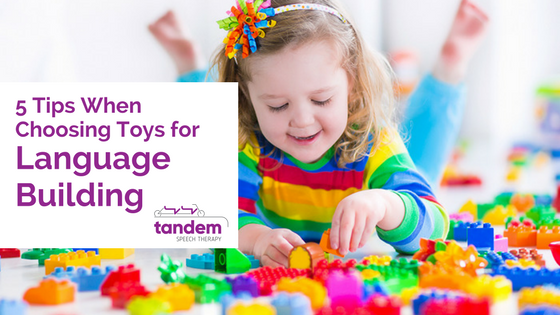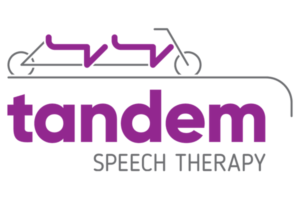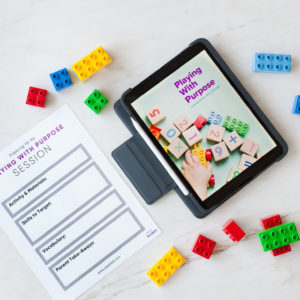If your child has dragged you down the toy aisles at Target recently, then you know how complicated choosing toys can be. You were bombarded by toys with sounds, lights, music, buttons, and the dreaded screen. When you purchase these types of toys, the toy does all the work and your child is likely to lose interest quickly.
Next time you are shopping for your child or a birthday party gift, keep these tips in mind and choose a toy that will support the development of critical early language and play skills.

- Skip the Batteries If the toy requires batteries, then you probably do not want it. Or if it does take batteries, remove them! Many years ago, as a new speech-language pathologist, I bought a farm set. The toy set itself is great. However, the barn has batteries so that it can make noises. I took the batteries out! You don’t need the barn to make noises. You want your CHILD to make the noises. Animal sounds such as “moo moo” for the cow are often some of the first words we hear from children.
- Go Back to the Basics Try picking traditional toys. Think back to toys you had as a child: wooden blocks, cars, a play kitchen and food set, a dollhouse, play dough, dress-up clothes, a tool set, etc. These are all open-ended toys. They are toys that have no beginning, middle, or end. They can be used in a variety of ways and allow your child creative freedom in how to use and manipulate them.
- Get Outside and Move It is so important to get kids moving, even when they are indoors. Whether you are playing inside or outside, you do not have to buy specific toys to get kids’ bodies moving. Head to the park or build a fort or a tunnel with the sofa cushions and a blanket. When you build a fort, you can work on skills such as: naming actions, problem-solving, building vocabulary and basic concepts (i.e., on/under/off, inside/outside, build, stack, crawl), and sequencing step or recalling the sequence of events.
- Less is More You have likely seen photos in magazines of the quintessential playroom. It is piled high with endless toys and games for children. Your child does NOT need toys upon toys. In fact, too many toys can be overwhelming. When children have too many toys, they end up moving quickly from one toy to another which can limit their play and language opportunities and contribute to decreased attention. If your child has just had a birthday or the holiday season is over, consider a toy rotation. This is an excellent way to reduce clutter and stay organized. Start by dividing your toys into sets, leave one set out, store the other set, and then rotate them whenever you would go shopping for something new.
- “YOU” are the Best Toy As mentioned above, you do not always need to go out and buy toys. Sometimes the best toys are not “real” toys at all. Pots, wooden spoons, cardboard boxes, homemade forts, or a bucket and cup for water play can be the best toys for your child. They can be creative, and you can enhance their opportunities for creative expression and play.. Think outside the box, and get down on the floor and interact with each other. Sing with your child, play patty-cake, talk in a funny voice, tell stories, be silly, play hide-and-seek, teach your child finger plays, or play a lap game. Interaction is the basis for communication.
Need help buying a gift/toy for a specific child?
Start Playing With Purpose
Learn how to purposefully and intentionally interact with your child during play and help them increase opportunities for speech and language development with our Playing with Purpose book!










